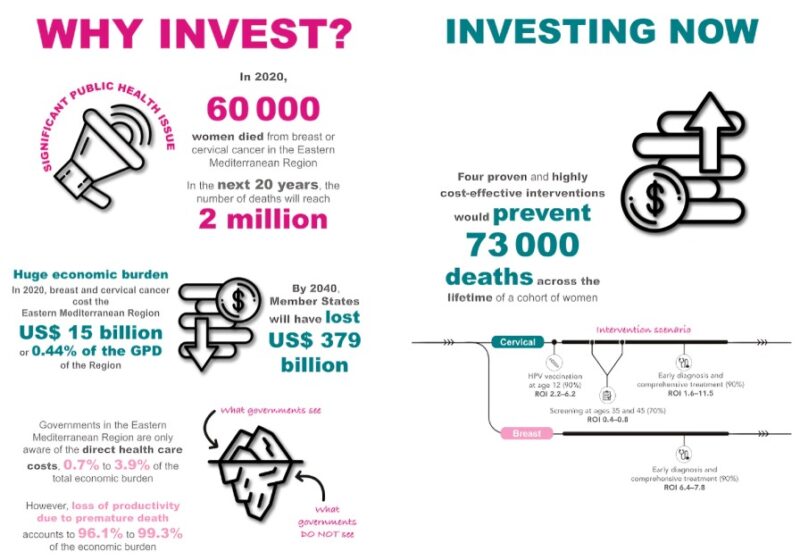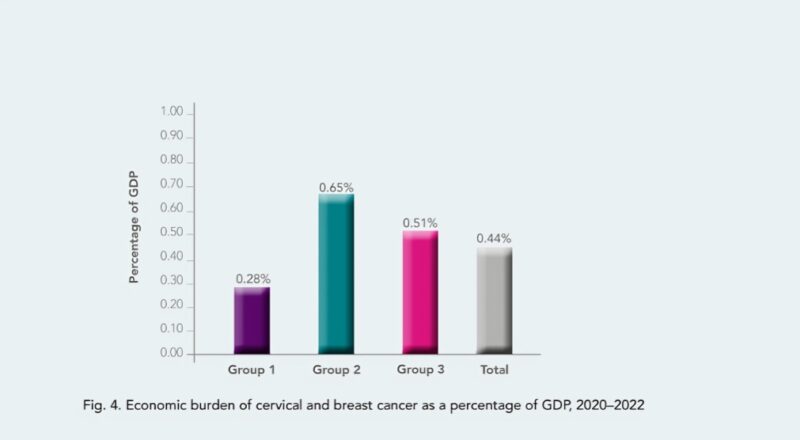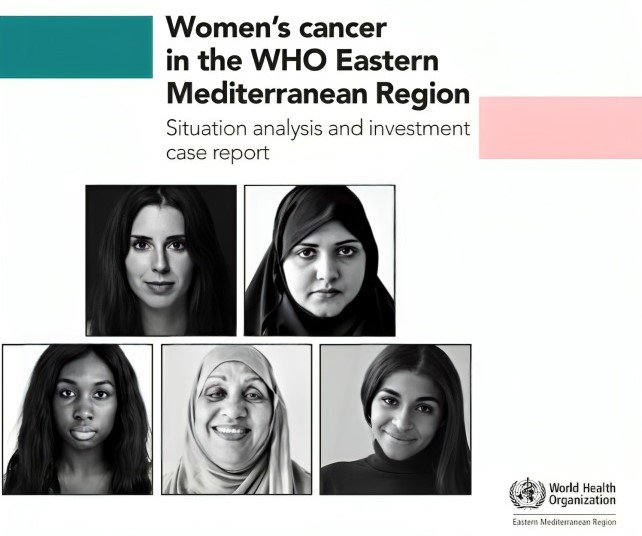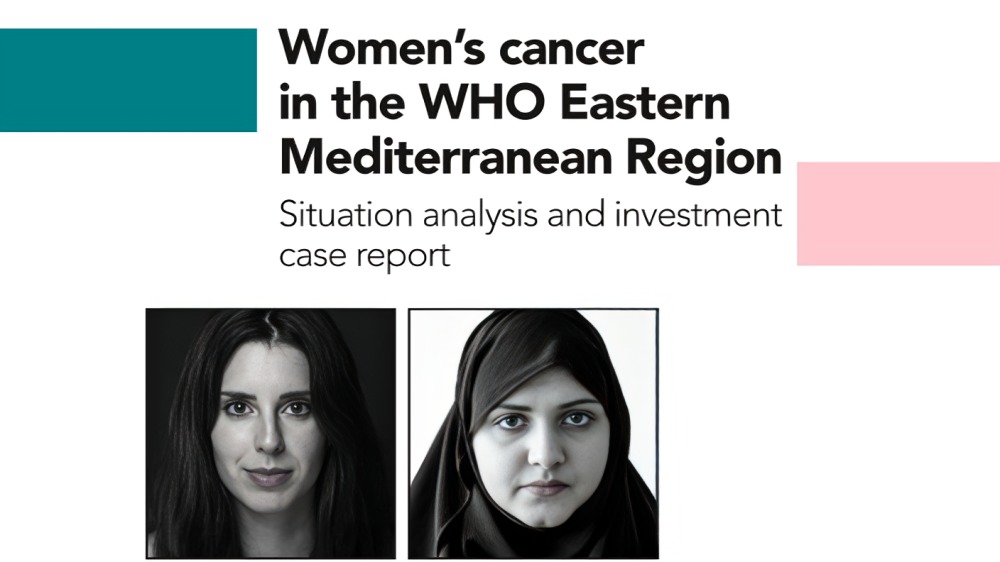In the WHO Eastern Mediterranean Region, women’s cancers, especially cervical and breast cancer, are a major public health concern.
Breast cancer is the most common cancer in the Eastern Mediterranean Region, and disparities in cervical cancer rates reflect differences in access to diagnosis and treatment, particularly in countries with lower Human Development Index levels. These cancers also impose economic burdens through healthcare costs and lost productivity.
Many countries in the Region have implemented national cancer control plans, focusing on screening, early diagnosis, and HPV vaccination.
Annually, there are 120,000 new breast cancer cases and 49,000 deaths, while cervical cancer causes around 15,000 new cases each year.

WHO has launched two key global initiatives: the Global Breast Cancer Initiative (GBCI), aimed at reducing breast cancer incidence by 2.5% annually, and the Cervical Cancer Elimination Initiative, which seeks to eliminate cervical cancer by 2120 through vaccination, screening, and treatment.
Despite progress, challenges remain in access to care, survival rates, and screening uptake. Misconceptions, fear, and systemic issues hinder early diagnosis and treatment. A comprehensive strategy is needed, including public education, improved access to care, and innovative solutions like HPV self-testing.
This investment case highlights the economic burden of cervical and breast cancer from 2020 to 2040, assesses the return on investment for WHO-recommended interventions, and provides recommendations for strengthening the regional response. It aims to guide policy decisions, support global and regional initiatives, and improve the health of women in the Eastern Mediterranean Region.
Key Findings
Health and Economic Burden
- Cancer Impact: In 2020, there were 81,900 breast cancer cases and 9,500 cervical cancer cases. Projections estimate over 3 million cases and 2 million deaths by 2040. These cancers caused 1.4 million years of life lost (YLL) in 2020, with 45 million YLL expected by 2040.
- Economic Costs: The 2020 economic burden was USD 15 billion, primarily driven by productivity losses. By 2040, the burden is projected to rise to USD 379 billion, with breast cancer accounting for most costs due to its higher incidence.
Intervention Effectiveness
- Primary Prevention: HPV vaccination is highly cost-effective, with a return on investment (ROI) ranging from 2.2 to 6.2 across different income groups. Other preventive measures for breast cancer include reducing tobacco use, promoting physical activity, and breastfeeding.
- Screening and Treatment: Cervical cancer screening has a lower ROI (0.4–0.8), but comprehensive treatment for both cancers shows positive ROIs, making treatment programs economically viable.
Regional Health Systems Analysis
Governance and Policies
- 14 countries have national cancer control plans, and 15 include cancer in broader health strategies. Breast cancer policies are more prevalent than cervical cancer initiatives.
Prevention and Early Detection
- Six countries have HPV vaccination programs, though uptake is inconsistent. Opportunistic screening is common, but organized screening programs are more effective.
Challenges in Access and Awareness
- Limited knowledge of cervical cancer risk factors, especially in lower socioeconomic groups, along with cultural barriers, hinders screening participation.
Economic Analyses
Cost–Effectiveness and ROI
- HPV Vaccination: Reduces cervical cancer incidence by 81%, with an ROI ranging from 2.2 in high-income countries to 6.2 in low-income regions.
- Comprehensive Treatment: Shows effective ROIs between 6.4 and 11.5.
- Screening Programs: Less cost-effective for cervical cancer, suggesting the need for resource reallocation.

Recommendations
Integrated Health Strategies
- Incorporate women’s cancers into broader health and cancer control policies and expand maternal and child health platforms to include cancer prevention and treatment.
Enhanced Prevention and Screening
- Strengthen HPV vaccination campaigns and develop organized, equitable screening programs supported by robust referral systems.
Public Awareness and Advocacy
- Tailor education campaigns to cultural and linguistic contexts, involving community health workers to overcome barriers and improve outreach.
Investment in Treatment Infrastructure
- Expand access to cost-effective treatment facilities and ensure continuous availability of essential cancer medicines.

“The World Health Organization Eastern Mediterranean Region is taking a significant step forward in addressing breast and cervical cancer, two of the most pressing public health challenges facing women. At the request of Member States, WHO EMRO has developed a comprehensive situation analysis and investment case to provide evidence-based guidance and actionable recommendations.
This report highlights the heavy toll these cancers take on lives and economies:
– 60,000 women died of breast and cervical cancer in 2020. Without action, this number will soar to 2 million over the next 20 years.
– These cancers cost the Region USD 15 billion in 2020, with productivity losses due to premature death accounting for 96–99% of the economic burden. By 2040, the cost will rise to USD 379 billion.
But there is hope. The report identifies proven, cost-effective interventions that could prevent 73,000 deaths and yield substantial economic returns. For example:
HPV vaccination at 90% coverage offers an ROI of up to 6.2.
Early diagnosis and treatment of breast cancer delivers an ROI of 6.4–7.8.
To ensure impact, the report recommends an integrated approach that places cancer prevention and control within primary health care systems, supported by equitable access to treatment and culturally appropriate health communication.
This initiative represents a vital response to Member States’ calls for evidence, economic data, and prioritization strategies. Together, we can reduce the devastating impact of women’s cancers and create healthier, more resilient communities across the Region.”
